In the world of encoding, there are many different types of encoders. One such encoder is the priority encoder. This type of encoder is used to ensure that certain packets of data are sent before others. In this article, we will discuss what a priority encoder is and how it works. We will also provide some tips on how to use a priority encoder to improve your encoding process.
What is Priority Encoder
In other words, it takes several digital signals (bits) as inputs or “inputs” and outputs a single encoded output based on which input has the highest priority. Priority Encoders assign each input a specific weight or “priority”; this means that if two or more inputs are active at the same time, the one with higher priority will be chosen over the others.
For example, consider an 8-bit Priority Encoder with a set of 8 inputs, each given different weights (priority values) from 1 to 8 respectively. If three of the eight inputs are active simultaneously, the Priority Encoder will identify which input has the highest priority value and output a corresponding binary code for it.

Priority Encoders are commonly used in digital logic circuits where multiple signals need to be combined into one signal or reducing complex signals into simpler outputs. They can also be used as address decoders when several memory locations need to be accessed at once. Additionally, they play an important role in circuit design; by providing a single output based on priority, they simplify and reduce the amount of circuitry needed in many designs while improving speed and performance.
There’s one disadvantage of using a priority encoder, which is that its output is dependent only on the highest priority input. This means that if two or more inputs have the same priority value, only one of them will be chosen and the other will be ignored.
It also can produce an error at its outputs if more than one input were active at the same time. To solve this problem, a priority encoder with an enable feature (also known as interrupt) can be used; the enable input is given the highest priority and when it’s active all other inputs are ignored. [1], [2], [3]
Difference Between Encoder and Priority Encoder
One thing that is important to understand is that encoders and priority encoders are different. An encoder takes in a set of digital inputs and outputs a binary code by turning each input into one bit. On the other hand, a priority encoder will take several inputs and assign them with priority values; it will then select the highest valued signal to generate its output.
The main difference between an encoder and a priority encoder lies in their functionality; an encoder generates an error output when more than one input is high, while a priority encoder will only identify the highest valued input. This is useful in situations where more than one signal can be active but only one needs to be encoded for further use.
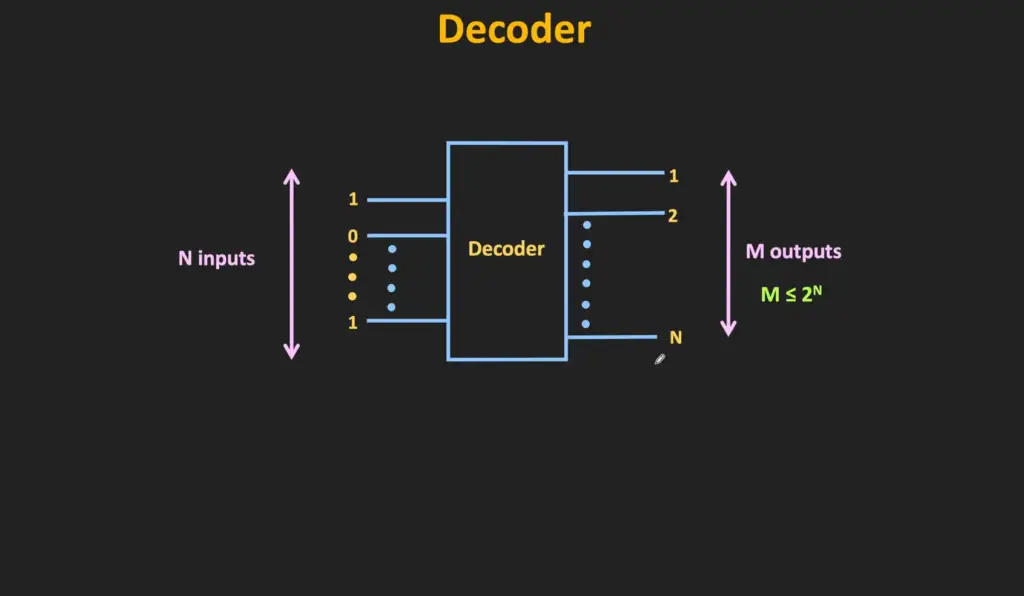
Priority encoders consider the highest priority input when generating the encoded output, and will discard all other lower valued inputs. This makes them an ideal choice for applications where signals need to be combined into a single output or simplified as much as possible. [1], [2]
Types of Priority Encoders
Just like many other digital components, there are different types of priority encoders available. Let’s discuss the types and their benefits.
8 to 3 Priority Encoder
An 8 to 3 Priority Encoder is a digital circuit that takes an 8-bit input and produces a 3-bit binary value. It is used to encode data from multiple inputs into a smaller number of codes, or “encodings”. The encoder works by assigning each bit of the 8-bit input a priority, usually in descending order (i.e., the highest priority goes to the most significant bit). When two or more bits are active (i.e., “1”) at the same time, only the one with the highest priority will be considered valid and outputted as part of the 3-bit coding. Another name for this encoder is Octal to Binary encoder.
An 8 to 3 Priority Encoder can also be used to determine which of multiple simultaneous requests has precedence in terms of execution. For example, it can be used in a CPU to decide which of multiple instructions should be executed first.
In addition to its use in data encoding and instruction execution, the 8 to 3 Priority Encoder is often used in digital systems where precise timing is needed due to its relatively small circuit size. By reducing the number of bits that must be processed, the encoder helps to speed up system operations and reduce power consumption. As such, it can help to maximize performance and efficiency in embedded systems or other computing applications.
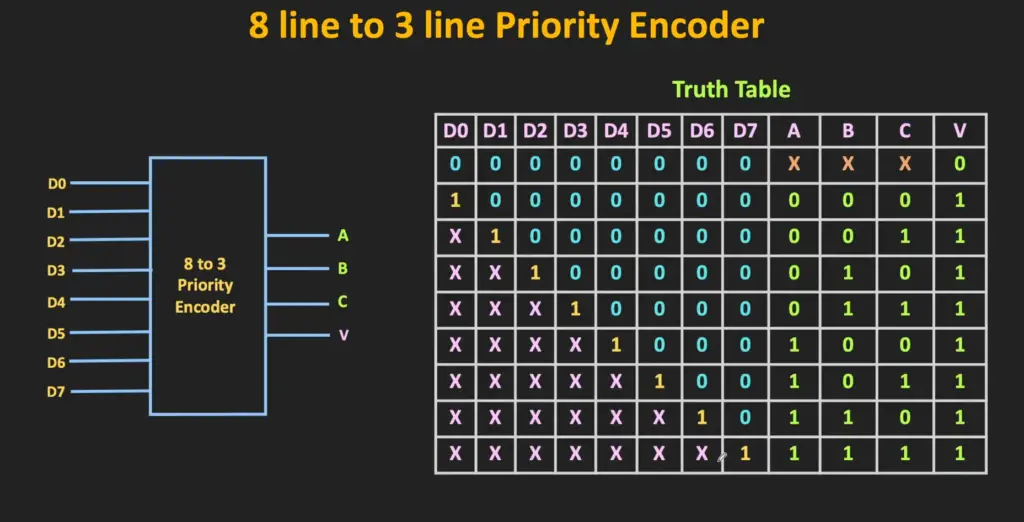
A 4 to 2 priority encoder
A 4 to 2 priority encoder is a digital logic circuit that accepts four binary inputs and produces two outputs. The output of the priority encoder will be determined by which of the four inputs are active (logic 1). The highest priority input has the most significant bit output, while the lowest priority input has the least significant bit output.
The 4 to 2 Priority Encoder uses a concept called “priority encoding” in order to determine which input is active. This means that when multiple inputs are active, only one of them will be chosen as having higher precedence over the others. For example, if all four inputs are set to logic 1, then the highest-priority input will have its corresponding bit selected for output.
The 4 to 2 Priority Encoder is a useful tool for digital logic circuits, as it can reduce the number of signals that need to be processed and thus reduces power consumption and improves overall system performance. It is often used in memory address decoding and instruction execution systems, where precise timing is needed. Additionally, its small circuit size makes it an attractive choice for embedded applications like automotive or industrial systems. [1], [2], [3]
Applications of Priority Encoders
Now that we’ve discussed the types of priority encoders, let’s discuss some of their applications. Priority encoders are used in a wide range of digital systems and applications. Let’s take a look at some of the most popular uses.
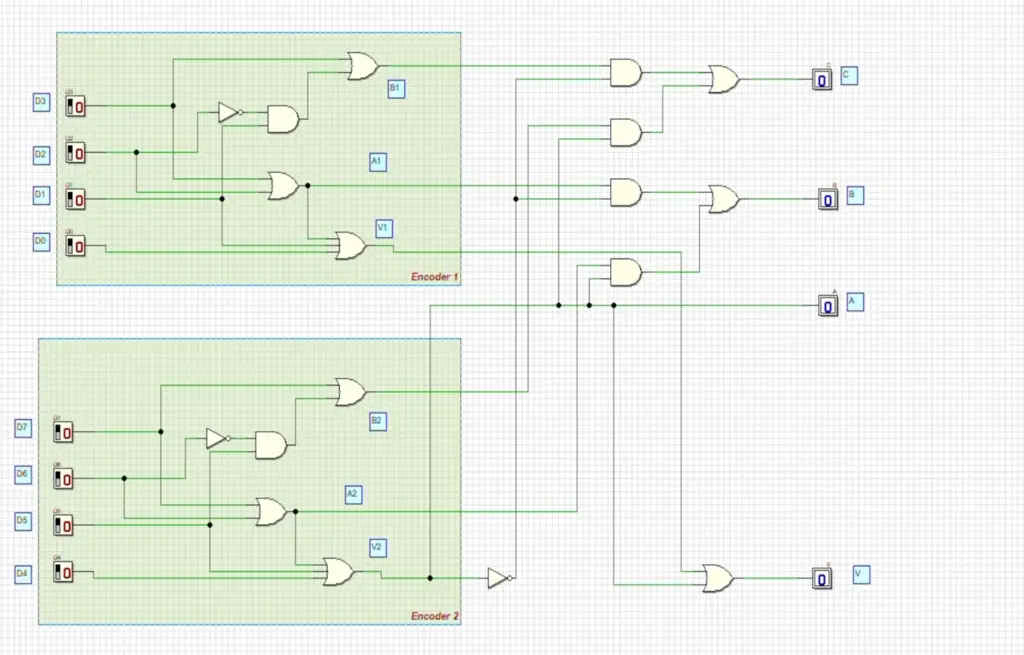
Keyboard Encoder
One of the most common applications of priority encoders is keyboard encoders. Keyboard encoders allow a computer to understand which key was pressed and therefore recognize input from the user. Keyboard encoders utilize priority encoding to assign each key its own unique code that can be recognized by the computer’s software. This makes it easy for computers to process multiple simultaneous inputs and make use of various features such as auto-correct, spell check, and voice recognition.
Positional Encoders
Positional encoders are used for applications that require data to be encoded in a particular order. They are often used to store information about the relative positions of different objects or images, for example. For example, positional encoders can be used in robotics to help robots determine their location on a map and make decisions based on that information. Additionally, they are commonly used in computer vision systems to interpret images by assigning each pixel’s position a value.
Priority Encoder Navigation
Priority encoders are used in a variety of applications, including priority encoder navigation. This type of navigation is used to control the precedence of data paths within a digital circuit. It is commonly used by microprocessors and electronic devices that need to rapidly process multiple inputs at the same time.
A priority encoder works by assigning priorities to each input so that it can determine which one should be processed first. By encoding these signals with an assigned priority, it ensures that the most important signal will always be dealt with before any other signals present in the circuit.
For example, when creating a system for controlling lights in a home automation setup, we would want each sensor placed in different rooms to have its own priority. As a result, when the system determines an urgent event (like a fire alarm) it can quickly shut off all lights and other devices in the house to avoid any further danger.
Interrupt controllers
A priority encoder is used to prioritize interrupts in an interrupt controller. An interrupt controller is responsible for managing the interrupt requests that are sent from different devices or peripherals on a computer system. These requests can come from multiple sources, sometimes simultaneously, and it’s important to ensure that the most important requests are dealt with first.
This is where a priority encoder comes into play. A priority encoder receives all of these incoming requests and then assigns them a numerical value based on their importance or urgency. This encoding process allows the controller to easily identify which request should be serviced first among the many available interrupts within the system.
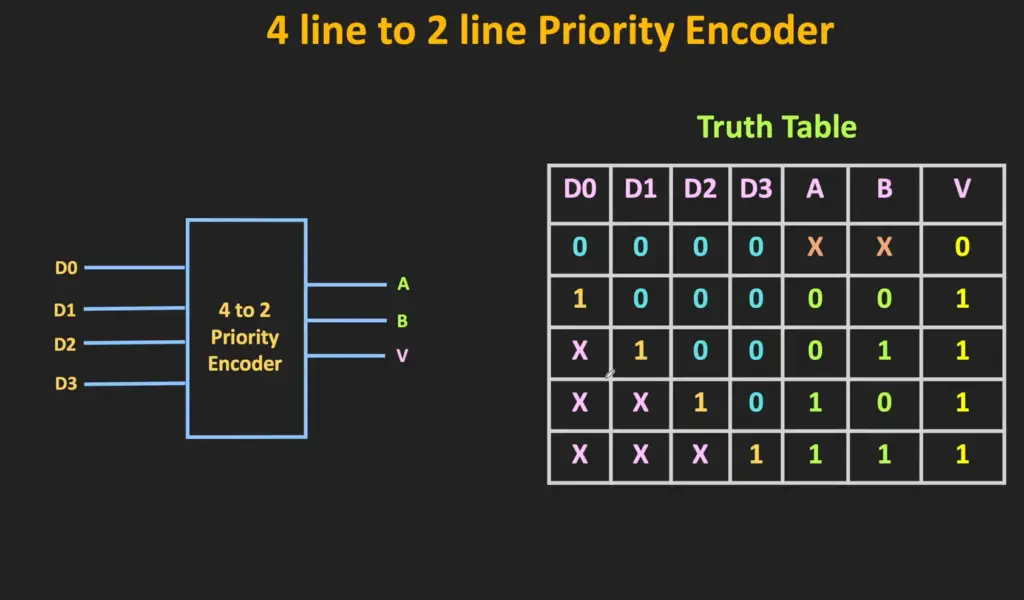
Robotic vehicles
Priority encoders are used in robotic vehicles to ensure accuracy and precision of navigation. The priority encoder receives input from sensors like ultrasonic rangefinders and camera systems, then processes the information, determining the most important sensory data. This ensures that the vehicle can accurately navigate its environment without having to process all incoming sensory data at once.
Applications of home automation systems
Priority encoders are commonly used in home automation systems. They can be used to send signals between devices, such as lights and thermostats. For example, a priority encoder could be used to activate the air conditioner when a certain temperature is reached or turn off the lights when it gets dark outside. Other applications include controlling security systems, monitoring energy usage, and connecting multiple appliances in order to control their output simultaneously.
Most of the time they are paired together with RFs (radio frequency) or IRs (infrared) receivers and transmitters, allowing the user to control their home automation system remotely.
Secure communication systems
Priority encoders are used in secure communication systems, such as wired and wireless networks. They are designed to offer secure data transmission, by encoding the data into a specific sequence of binary numbers. This ensures that the data is transmitted securely, without being tampered with or intercepted by unauthorized sources. Additionally, priority encoders can be used to detect any errors in the signals received from the transmitting device.
Use in health monitoring systems
Priority encoders can be used in health monitoring systems, such as for heart rate or blood pressure monitors. In these systems, the priority encoder helps to prioritize which signals are sent back to the device. For example, if a patient’s heart rate is too high and there is an emergency situation, the priority encoder will ensure that this signal is given priority over any other signals being monitored. This ensures that critical information is always received in a timely manner.
Network protection
Priority encoders can be used to provide protection in networks by detecting the most important signals and giving them higher priority. They are often used as part of a system architecture that includes multiple levels of security to ensure that only valid data is allowed through the network. The advantage of using a priority encoder is that it can quickly detect which signal has the highest priority and then route it through the network, while simultaneously discarding any lower-priority signals. This makes it an effective tool for preventing unwanted traffic from entering or leaving a network. [1]

FAQ
What is a priority encoder?
It does this by assigning different weights — or priorities — to each bit, thus determining the order and value that will be sent out by the encoder. For example, if two inputs are provided (A and B), then A might have higher priority than B. This means that when both inputs are high (both 1s), only A’s output will be sent as a signal by the encoder.
What are the roles of an encoder?
They are used in many different applications, including data communication, audio and video processing, and control systems. The main role of an encoder is to reduce the amount of data required for transmission or storage by compressing it using a specific coding scheme. The most common types of encoding techniques are pulse code modulation (PCM), differential pulse code modulation (DPCM) and adaptive delta modulation (ADM).
What is the purpose of a priority encoder?
A priority encoder is a digital logic device that converts multiple binary inputs into its corresponding encoded output. It is used in computers to prioritize different signals according to their importance. The purpose of a priority encoder is to select the most important input and encode it so that the processor can act accordingly.
Priority encoders are typically used with processors or other digital devices that need to deal with simultaneous inputs, often from multiple sources. For example, a microprocessor might receive commands from several peripherals at once, but will only be able to process one command at a time. In this scenario, the priority encoder will read all the inputs and pick out which one should be processed first based on its importance level.
What are the differences between an encoder and a priority encoder?
An encoder is an electronic circuit that converts input information into a coded digital output. It typically takes one of several inputs, such as binary digits or analog signals, and produces a single encoded output. A priority encoder, on the other hand, is a type of encoder that uses priority levels to determine which input should be given priority over others when producing its output. This means it can take multiple inputs but only one output will be selected based on the set priorities.
A regular encoder may simply convert an input into a corresponding output without taking any other factors into consideration; whereas with a priority encoder, each input is compared against the others in terms of their designated importance or “priority” level, where the one with the highest priority is selected and converted into an output. This helps simplify encoding systems since it reduces the number of outputs generated by any given input, which can be useful in certain applications where multiple inputs must produce a single encoded result.
What is the priority encoder 16 to 4?
A priority encoder 16 to 4 is a digital circuit that is used to convert an arbitrary binary code (consisting of up to 16 bits) into a four-bit code. It does this by assigning priorities or hierarchical order for each bit and encoding the most significant bit first. The output of the encoder consists of one active-low (logic 0) output and three active-high (logic 1) outputs, which are generated based on the binary inputs.
What is meant by an 8 * 3 priority encoder?
An 8 * A 3 priority encoder is an encoder that can take up to 8 inputs and provide 3 unique outputs. It works by assigning a priority to each of the inputs, with the highest priority input being assigned the lowest number output. The lower the number output, the higher its priority.
For example, if there are eight inputs (A-H) and three outputs (1-3), then A would be given a numerical value of 1, B would be given 2, C would be given 3, etc., until H is given 8. When any of these inputs become active (i.e. a high voltage signal is applied to it), it will override all other inputs and produce a single output corresponding to its numerical value. This output is the priority encoded output.
For example, if A and H become active simultaneously, then the priority encoder will produce a numerical value of 1 for its output (since A has a higher priority than H). If D and G become active simultaneously, then the encoder will produce an output of 4 (since D has a higher priority than G). In this way, the 8 * 3 Priority Encoder allows us to encode up to 8 inputs into a single 3-bit binary code.
Useful Video: Priority Encoder
Conclusion
Priority encoders are a powerful tool used in many digital systems. By utilizing their ability to efficiently convert multiple input signals into one encoded output, they allow for the reliable and efficient communication of data.
The priority encoder has become a popular choice in many applications due to its ability to reduce the number of logic components required for implementation, combined with its low-power consumption and high speed performance. It is well suited for situations where there is a need for fast response time and reliability.
When selecting an appropriate priority encoder, it’s important to understand the design requirements as well as characteristics such as propagation delay and power dissipation. A thorough understanding of these considerations will help ensure optimal system performance by allowing you to select the best possible option for your unique application.
Ultimately, the priority encoder has become a popular choice for many digital systems due to its low component count and power consumption, as well as its robust performance capabilities. By following this guide, you will be well-equipped to choose the best possible option for your project’s needs.
Thanks for reading! We hope this guide provides useful insights into what is a priority encoder and how it can be used to provide efficient data communication.
We’d love to hear from you if you have any more questions or would like to share your experiences with the priority encoder. Feel free to leave us a comment below!
References
- https://www.elprocus.com/priority-encoder/
- https://www.electronics-tutorials.ws/combination/comb_4.html
- https://www.tutorialspoint.com/what-is-a-priority-encoder





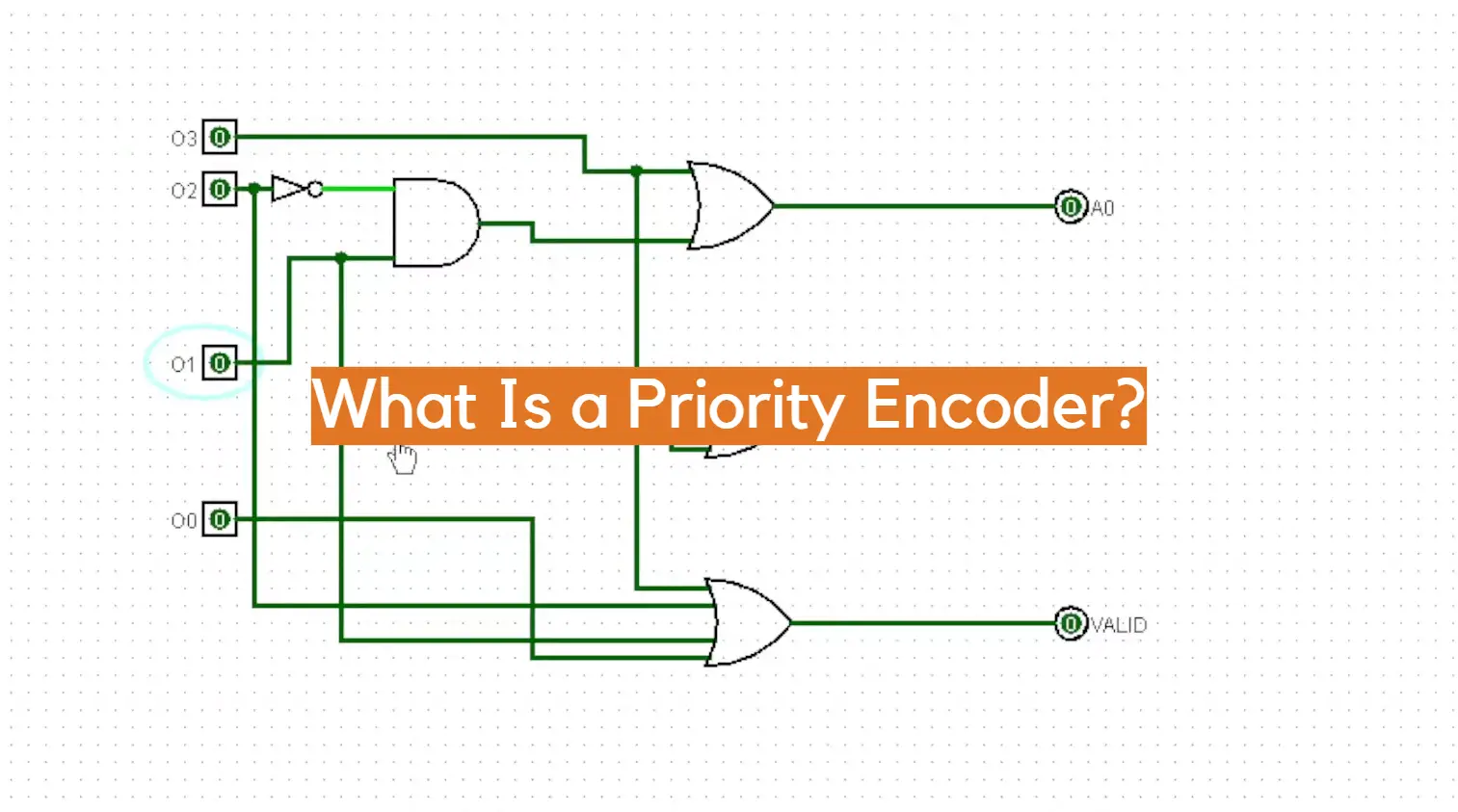







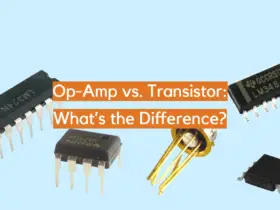
Leave a Reply